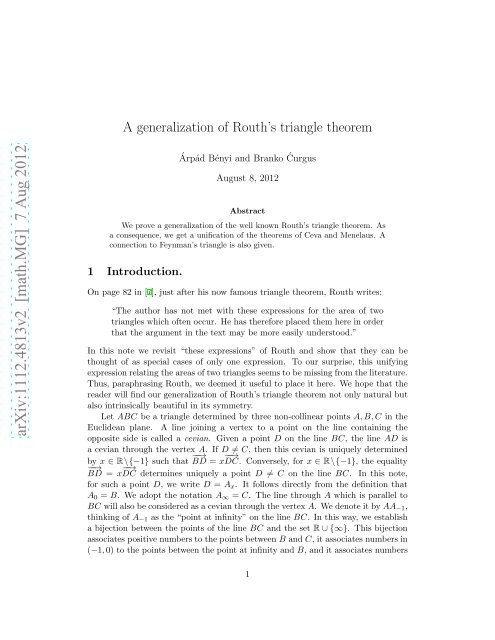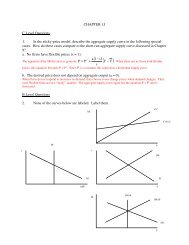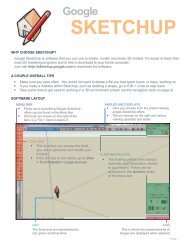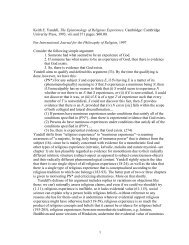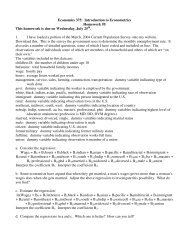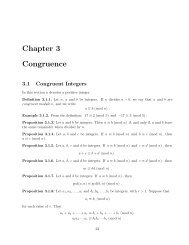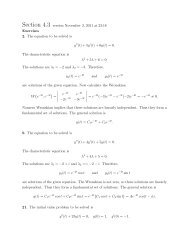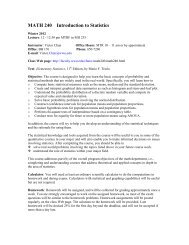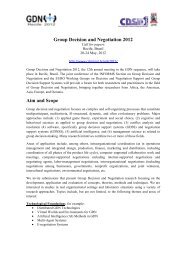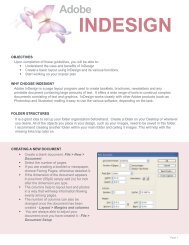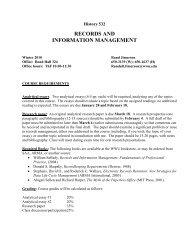A generalization of Routh's triangle theorem
A generalization of Routh's triangle theorem
A generalization of Routh's triangle theorem
Create successful ePaper yourself
Turn your PDF publications into a flip-book with our unique Google optimized e-Paper software.
and (x,y) ≠ (0,∞); this follows from the calculations preceding (6) below. Notealso that the cevians AA 0 and BB ∞ coincide.The <strong>triangle</strong> PQR will be called a Routh’s <strong>triangle</strong> <strong>of</strong> ABC. Notice that thepoints P,Q and R are collinear if and only if they coincide. Therefore, (2) impliesthat the lines AA x ,BB y and CC z are concurrent if and only if xyz = 1. Thisstatement is known as Ceva’s <strong>theorem</strong>, [2, p. 220].3 A unification.An extension <strong>of</strong> theconstruction by Nakamura andOguiso [5, §3] allows for formulas(1) and (2) to be unified. For u,v,w,x,y,z ∈ R∪{∞}, consider the following sixcevians, two from each vertex: AA u ,AA x ,BB v ,BB y ,CC w ,CC z . Assuming thateach <strong>of</strong> the pairs <strong>of</strong> cevians (AA x ,BB v ), (BB y ,CC w ) and (CC z ,AA u ) intersectsat exactly one point, we define the generalized Routh’s <strong>triangle</strong> PQR <strong>of</strong> the given<strong>triangle</strong> ABC, see Figure 1, by setting{P} = AA x ∩BB v , {Q} = BB y ∩CC w , {R} = CC z ∩AA u . (3)CB vA xPB yQA uA C w C z BFig. 1: A generalized Routh’s <strong>triangle</strong>RNote that the discussion in the paragraph following (2) implies that the pointsP,Q and R in (3) are well defined if and only if x,y,z,u,v,w ∈ R∪{∞} satisfy(1+x+xv)(1+y +yw)(1+z +zu) ≠ 0. (4)3
Choosing u = x,v = y, and w = z the <strong>triangle</strong> PQR defined in (3) becomes aRouth’s <strong>triangle</strong>, see Figure 2. On the other hand, choosing u = v = w = 0 we haveAA 0 = AB,BB 0 = BC,CC 0 = CA, and (3) yields P = A x ,Q = B y ,R = C z . Inthis case, the <strong>triangle</strong> PQR is the cevial <strong>triangle</strong> A x B y C z , see Figure 3.CCB vRA uA xPA xB yB vPQB y QA uAC z C wFig. 2: Almost Routh’s PQRBAC w C z BFig. 3: Almost a cevial PQRRTheorem. With the points P,Q,R defined in (3), the ratio between the area ∆ 1 <strong>of</strong>the <strong>triangle</strong> PQR and the area ∆ <strong>of</strong> the <strong>triangle</strong> ABC is given by∆ 1∆=1−xyw−xvz −uyz +xyz +xyzuvw(1+x+xv)(1+y +yw)(1+z +zu) . (5)The natural domain <strong>of</strong> (5) is the set <strong>of</strong> all (x,y,z,u,v,w) ∈ R 6 which satisfy (4).However, it is again an exercise in multivariable limits, this time with six variables,to check that formula (5) extends by continuity to all (x,y,z,u,v,w) ∈ (R∪{∞}) 6which satisfy (4). Beautifully, with u = x,v = y,w = z, (5) simplifies to (2) andwith u = v = w = 0, it simplifies to (1). Also, as x,y,z → ∞, formula (5) becomes(1), with x in (1) substituted by u, y by v, and z by w.It is quite possible that any <strong>of</strong> the many pro<strong>of</strong>s <strong>of</strong> Routh’s <strong>theorem</strong> (see, forexample, [2, Section 13.7], [4], [6], to mention a few) can be modified to prove this<strong>generalization</strong>. We will prove it by using two standard undergraduate tools: linearalgebra and analytic geometry. First, we observe that the ratio <strong>of</strong> the areas remainsunchanged under affine transformations <strong>of</strong> R 2 . Therefore, instead <strong>of</strong> an arbitrary<strong>triangle</strong> ABC, we can consider the <strong>triangle</strong> with the verticesA = (0,0), B = (1,0), and C = (0,1).Next, we find the coordinates <strong>of</strong> the point P for these special vertices A,B,C. Letξ denote its first coordinate and calculate A x = ( 1/(1 + x),x/(1 + x) ) ( )and B v =0,1/(1+v) . Now, intersecting the lines AAx and BB v we get ξx = (1−ξ)/(1+v).Solving for ξ gives the first coordinate <strong>of</strong> P, while the second coordinate is ξx.Similarly, we find Q and R; we haveP = ( 11+x+xv ,x1+x+xv), Q =(yw1+y+yw , 11+y+yw4), R =(z1+z+zu , zu1+z+zu). (6)
Let(□ stand)for(the left-hand)side(<strong>of</strong> (4). Since)we assume that each pair <strong>of</strong> ceviansAAx ,BB v , BBy ,CC w and CCz ,AA u intersects at exactly one point, we have□ ≠ 0. As the area <strong>of</strong> the <strong>triangle</strong> ABC is 1/2, the ratio in the <strong>theorem</strong> is given bythe determinant∣11+x+xvx1+x+xvyw1+y+yw11+y+ywz1+z+zuzu1+z+zu1 1 1= 1 1 yw z□x 1 zu∣ ∣ 1+x+xv 1+y +yw 1+z +zu ∣= 1 1 yw z□x 1 zu+ 1 1 yw z□x 1 zu+ 1 1 yw z□x 1 zu∣ 1 1 1 ∣ ∣ x y z ∣ ∣ xv yw zu ∣= 1 (1+ywzu+zx−z −zu−xyw)□+ 1 (z +ywzux+zxy −zx−zuy −zxyw)□+ 1 (zu+ywzuxv +zxyw−zxv −zuyw −zuxyw)□= 1 (1−xyw−xvz −uyz +xyz +uvwxyz).□This proves (5). As a consequence <strong>of</strong> our <strong>theorem</strong>, we also obtain the followingunification <strong>of</strong> the <strong>theorem</strong>s <strong>of</strong> Ceva and Menelaus.Corollary. The points P,Q and R defined in (3) are collinear if and only if1−xyw −xvz −uyz +xyz +xyzuvw = 0.For an animation which ties together these two classical <strong>theorem</strong>s <strong>of</strong> Euclideangeometry and which is inspired by this corollary, see [3].4 A connection to Feynman’s <strong>triangle</strong>.The Routh’s <strong>triangle</strong> with coefficients x = y = z = 2 attracted more attention thanany other, see for example [8, p. 9] and [1]. The area <strong>of</strong> this special Routh’s <strong>triangle</strong>equals 1/7 <strong>of</strong> the area <strong>of</strong> its host <strong>triangle</strong>. The pro<strong>of</strong> <strong>of</strong> this fact in [8, p. 9] is a tilingtype argument almost without words, while [1] gives three different pro<strong>of</strong>s usingstandard tools <strong>of</strong> Euclidean geometry. According to [1], this result kept RichardFeynman busy during a dinner. This story gave the <strong>triangle</strong> the name Feynman’s<strong>triangle</strong>; another name for it is the “one-seventh area <strong>triangle</strong>”.Further on, we assume that the host <strong>triangle</strong> has area 1. Feynman’s <strong>triangle</strong> isunique in the sense that no other Routh’s <strong>triangle</strong> with equal integer coefficients5
argument along the lines <strong>of</strong> [8, p. 9] for the claims indicated in the last two figures.References[1] R. J. Cook, G. V. Wood, Feynman’s Triangle, Mathematical Gazette 88 (2004),299-302.[2] H. S. M. Coxeter, Introduction to Geometry, second edition. John Wiley &Sons, Inc., New York-London, 1969.[3] B. Ćurgus, The <strong>theorem</strong>s <strong>of</strong> Ceva and Menelaus: an animation, available athttp://myweb.facstaff.wwu.edu/curgus/Papers/Monthly2012.html.[4] J. S. Kline, D. Velleman, Yet another pro<strong>of</strong> <strong>of</strong> Routh’s <strong>theorem</strong>, Crux Mathematicorum21 (1995), 37-40.[5] H. Nakamura, K. Oguiso, Elementary moduli space <strong>of</strong> <strong>triangle</strong>s and iterativeprocesses, The University <strong>of</strong> Tokyo. Journal <strong>of</strong> Mathematical Sciences 10(2004), 209-224.[6] I. Niven, A New Pro<strong>of</strong> <strong>of</strong> Routh’s Theorem, Mathematics Magazine 49 (1976),25-27.[7] E. J. Routh, A Treatise on Analytical Statics with Numerous Examples, Vol.1, second edition. Cambridge University Press, London, 1909, available athttp://www.archive.org/details/texts.[8] H. Steinhaus, Mathematical Snapshots, third English edition. Translated fromthe Polish. With a preface by Morris Kline. Dover Publications, Mineola, NY,1999.Department <strong>of</strong> Mathematics, Western Washington University, Bellingham, WA 98225,USA,Arpad.Benyi@wwu.eduDepartment <strong>of</strong> Mathematics, Western Washington University, Bellingham, WA 98225,USA,Branko.Curgus@wwu.edu7


